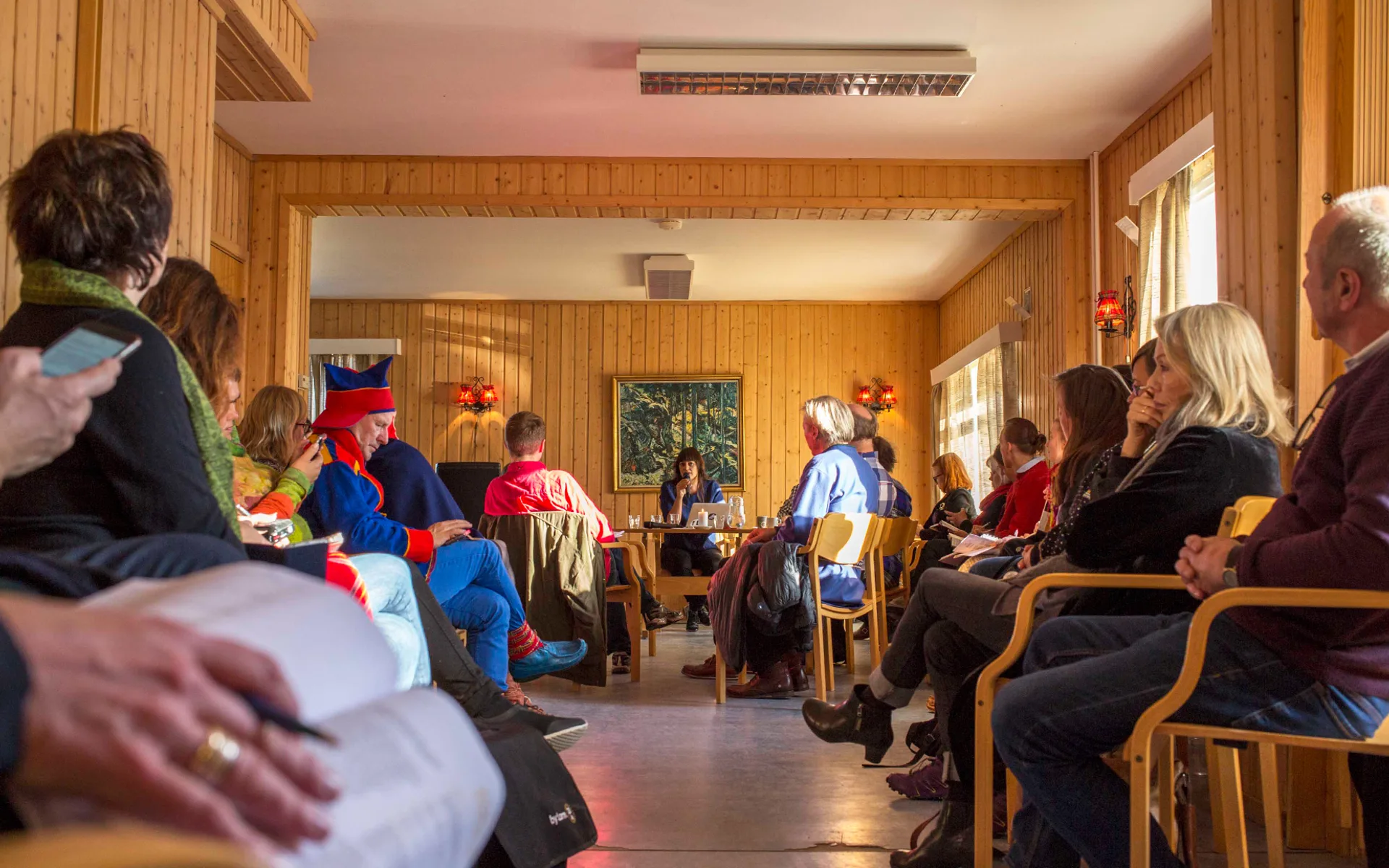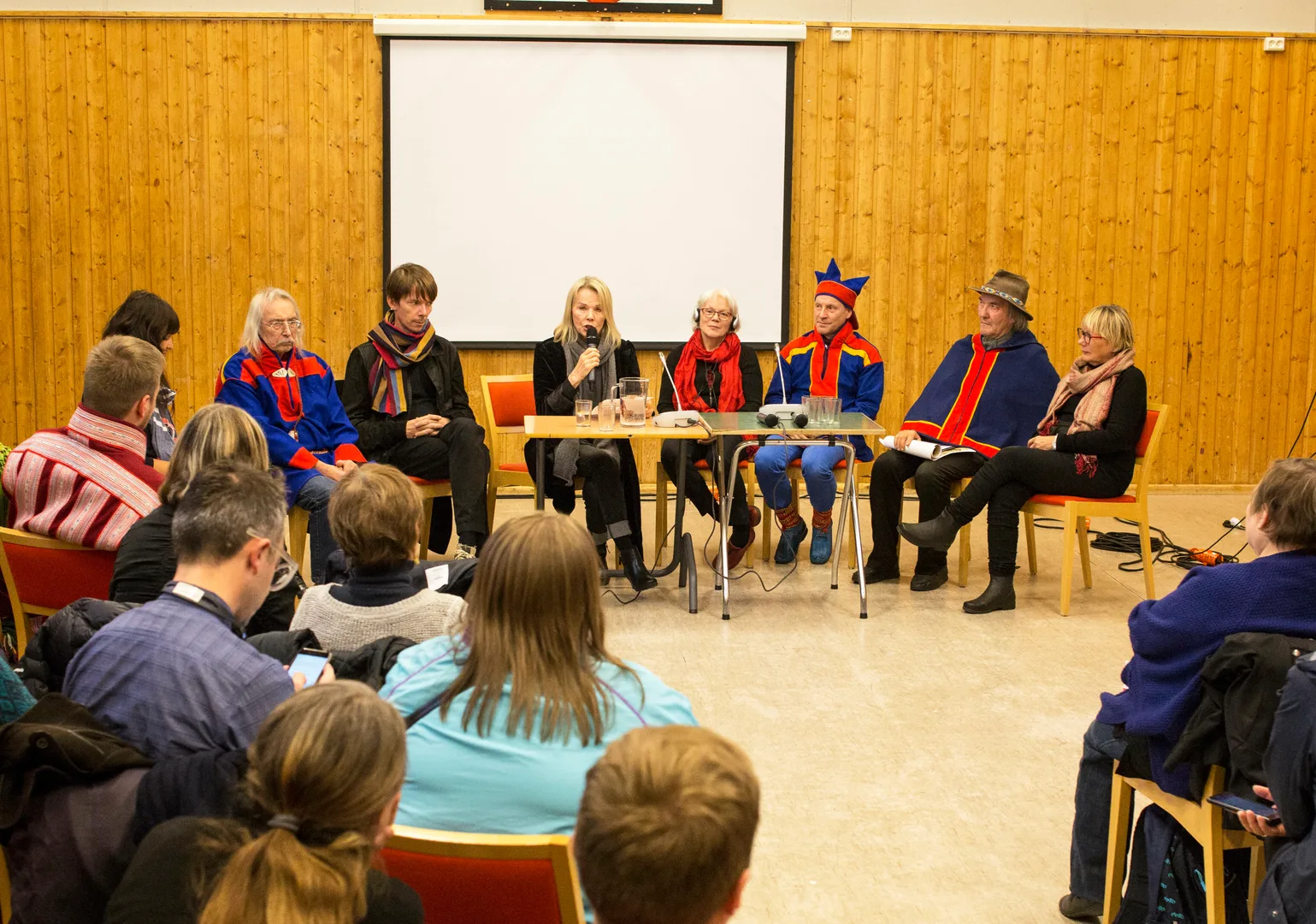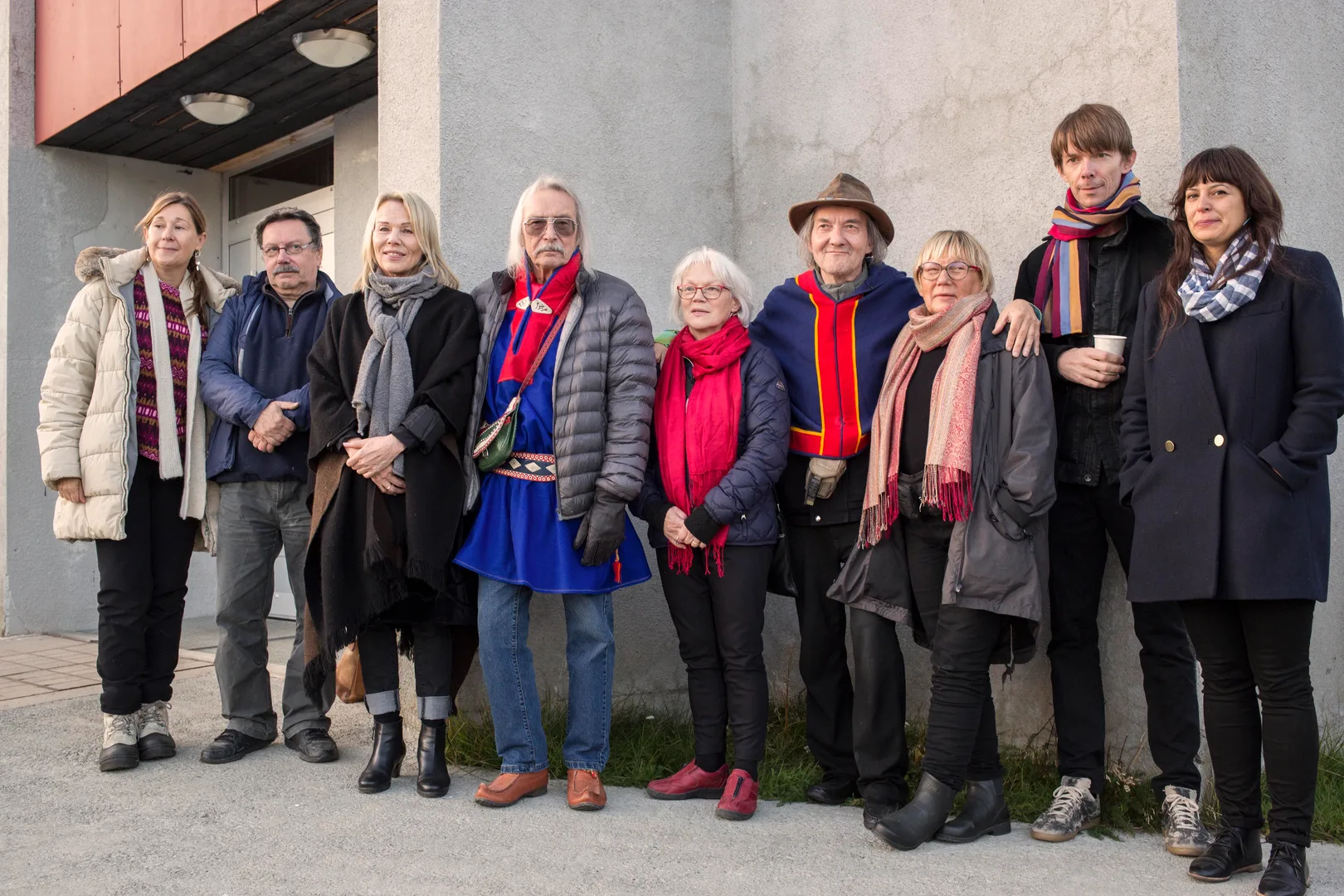
Relaunch of the Mázejoavku housing and studios
In 2017 OCA and The Sámi Paliament of Norway/Sámediggi hosted a three-day gathering with a series of workshops and a panel discussion in the town of Máze, to work towards the creation of an Indigenous arts residency in the legendary Mázejoavku: Sámi Dáiddajoavku housing and studios.

Panel discussion with Aage Gaup, Josef Halse, Berit Marit Hætta, Keviselie/Hans Ragnar Mathisen, Britta Marakatt-Labba, Rannveig Persen, Synnøve Persen (the Mázejoavku: Sámi Dáiddajoavku artists), Ánde Somby and Adam Szymczyk, moderated by Candice Hopkins. Photo: Susanne Hætta

Sonic workshop with Raven Chacon and Johan Sara Jr. Photo: Susanne Hætta
Together with local partners in Sápmi, regional and international advisors and supporters, the Sámediggi has commissioned the establishment of a foundation in the legendary Mázejoavkku: Sámi Dáiddajoavkku housing and studios. Furthermore, the process of bringing the house back to life is accompanied by a series of initiatives, first of all including a workshop on Indigenous Methodologies, addressed to Sami artists and curators, facilitated by the three Sami scholars Harald Gaski, Rauna Kuokkanen, and Jelena Porsanger, with writer and documenta14 curator Candice Hopkins. A second Sonic workshop exploring field recordings, has been developed by Máze-based leading musician and composer Johan Sara Jr. and the experimental composer and artist Raven Chacon. A third workshop exploring Indigenous Aesthetic Language within art, craft and creativity will feature presentations and interactive discussions with artists Gunvor Guttorm, Britta Marakatt-Labba and Julie Edel Hardenberg. In addition a chapter of a cycle of interviews conducted in 2008 with artist Trygve Lund Guttormsen by Rossella Ragazzi and Terje Brantenberg, Associate Professors at Tromsø University Museum, the Arctic University of Norway was screened.
A panel discussion celebrating the Mázejoavkku addressed past, present and future aspects of its activity. The panellists included various members of the legendary Mázejoavkku: Sámi Dáiddajoavkku (Sámi Artists’ Group); Ánde Somby, member of the work group to create the future Mázejoavkku foundation; and Adam Szymczyk, artistic director of the documenta14.
In parallel to the main events, documentation together with a selection of artworks illustrating Máze’s role during the Alta Actions of the 1970s, was organised by RiddoDuottarMuseat.
Programme
DAY 1
Sunday, September 24
Venue: Máze school
10:00-12:00
Sonic workshop with Raven Chacon and Johan Sara Jr (part 1)
Open air field recording. Meeting point: Grendehuset
Raven Chacon and Johan Sara Jr. will lead a two-day workshop for composing with ambient sounds and field recordings. The first day will allow participants to explore the local Máze landscape to gather sounds, while Day 2 (optional) has a smaller group editing and processing them in the studio. The final composition will become part of a larger, online open source audio composition that can be accessed or added to by other composers and artists internationally.
Raven Chacon is a composer, performer and installation artist based in Albuquerque, New Mexico. He is also a member of the Indigenous art collective Postcommodity, and he is featured in documenta 14. Chacon is Navajo.
Johan Sara Jr. is a composer, guitarist and yoiker born in Guovdageaidnu (Kautokeino) and based in Máze. Sara Jr. is Northern Sami.
12:00-12:30 Lunch
12:30-17:00
Sonic workshop with Raven Chacon and Johan Sara Jr (part 2)
Open air field recording. Meeting point: Grendehuset
– A small number of participants will also be invited to partake the second and more technical part of the Sonic workshop at Johan Sara Jr.'s studio on Monday, 25 September from 9 to 16.
17:10-18:00
Intro by John Gustavsen and screening of an interview with artist Trygve Lund Guttormsen by Rossella Ragazzi and Terje Brantenberg, Associate Professors at UiT – The Arctic University of Norway, Tromsø
18:00-19:30
Exhibition Opening:
‘Documentation Centre: Let the river live’
Venue: Oves varesenter
Organised by the RiddoDuottarMuseat and its Guovdageainnu gilišillju branch, this exhibition project is produced on the basis of historical documents and other material related to the Alta action of 1979. ‘Documentation Centre: Let the river live’ aims at showing what a documentation centre about the Alta-Kautokeino case in Máze could be. During the Alta actions, the Mázejoavku, a Sámi artist group was formed in Máze, and a selection of their works is part of the exhibition. Artworks and documentation material is drawn from RiddoDuottarMuseat's own collections and archives, together with historical documents and objects borrowed from the Alta museum. New additional documentation has been collected with film and interviews. The project partners are the Sami Center for Contemporary Art,
Sami archive, Alta museum, DAVÁS Film, RDM-The Sami Collections, RDM-Sami Art Magazine, Oves Varesenter in Máze, and Nature Conservation Association Ávjovárri. The project is funded by the Sami Parliament, Finnmark County Council, Norsk Kulturråd and RiddoDuottarMuseat.
20:00
Dinner
Venue: Grendehuset
DAY 2
Monday, September 25
Venue: Grendehuset
10:00-12:00
Indigenous Methodologies workshop by Harald Gaski, Rauna Kuokkanen
and Jelena Porsanger, with Candice Hopkins (part 1)
Venue: Grendehuset
The Indigenous Methodologies workshop is facilitated by three Sámi scholars Rauna Kuokkanen, Jelena Porsanger and Harald Gaski, together with Tlingit curator and scholar Candice Hopkins. The workshop begins with a roundtable by the facilitators who will discuss how they have engaged with and developed Sámi and Indigenous methodologies and how their work has been informed and inspired by other Indigenous methodologies. The topics that will be discussed under the broad theme of Sámi and Indigenous methodologies include Sámi and Indigenous arts, resistance, decolonization, yoik songs, gender, traditional knowledge and values, Indigenous politics, self-determination and resurgence. The structure of the workshop is informal dialogues on these topics and the aim is to engage the participants in an interactive conversation with a specific focus on Sámi priorities and perspectives.
Harald Gaski is Associate Professor in Sami literature at UiT – The Arctic University of Norway, and the author and editor of several books, journals and articles on Sami literature and culture. Gaski is Northern Sami, originally from Deatnu, Sápmi/Norway.
Rauna Kuokkanen is Research Professor of Arctic Indigenous Politics at the University of Lapland, Finland. She also holds a position of Associate Professor at the Department of Political Science and Indigenous Studies Program at the University of Toronto, Canada. Kuokkanen is Northern Sami from Ohcejohka (Utsjoki), Sápmi/Finland.
Jelena Porsanger is a Sámi scholar with a doctoral degree in the history of religion and philosophy. Porsanger is Kildin Sami, originally from Lovozero, Sápmi/Russia.
Candice Hopkins is an internationally respected writer, researcher as well as a curator for documenta 14. Hopkins is Tlingit, originally from Whitehorse, Yukon.
12-12:30 Lunch
12:30-16:00
Indigenous Methodologies workshop by Harald Gaski, Rauna Kuokkanen
and Jelena Porsanger, with Candice Hopkins (part 2)
Venue: Big lavvo
16:00-16:50
Presentation by Raven Chacon and Johan Sara Jr on the Sonic workshop
Venue: Big lavvo
17:00
Coffee & Snacks
Venue: Máze school (outside)
17:30
Official opening
Venue: Máze school
17:45-19:15
Panel discussion with Aage Gaup, Josef Halse, Berit Marit Hætta, Keviselie/Hans Ragnar Mathisen, Britta Marakatt-Labba, Rannveig Persen, Synnøve Persen (the Mázejoavku: Sámi Dáiddajoavku artists), Ánde Somby and Adam Szymczyk, moderated by Candice Hopkins
Venue: Máze school
19:15
Concert with yoik and instrumental sound, including a music performance by Isak Samuel Klementsen Hætta
Venue: Máze school
19:45
Dinner
Venue: Grendehuset
Tours
Venue: Mazejoavku house
DAY 3
Tuesday, September 26
10:00-12:00
Indigenous Aesthetic Language workshop with Gunvor Guttorm and Britta Marakatt-Labba (part 1)
Venue: Grendehuset
12-12:30 Lunch
12:30-16:00
Indigenous Aesthetic Language workshop with Sissel M Bergh, Tomas Colbengtsson, Unni Fjellheim, Julie Edel Hardenberg and Lena Kappfeldt (part 2)
Venue: Grendehuset
This explorative indigenous aesthetic language workshop includes talks, conversations and discussions on the languages of art, craft and creativity in the indigenous languages of North Sami, South Sami and Kallaalut, among others, to address the question of How do we talk art? Artist and educator Gunvor Guttorm, will lecture about the concept of “leatgo duodjedoahpagat” (vital living curiosity) to ask if applying aesthetic concepts in duodji (Sami crafts) is necessary or simply a curiosity? Guttorm’s address will be followed by a conversation between her and artist Britta Marakatt-Labba about North Sami aesthetics and languages, taking the book Sággon Muitalusat (Embroidered Stories) as a starting point.
The second part of the day will commence with a presentation by artist Julie Edel Hardenberg on her artistic relationship with her own language (Kalaallut). Language themes and challenges within artistic work will continue to be explored with informal, open, roundtable conversations about Southern Sami language (and language loss) and aesthetics; artistic practitioners and aesthetic terminology; culture and language, together with artists Sissel M Bergh, Tomas Colbengtson and duodji crafter/artist Unni Fjellheim moderated by cultural historian Lena Kappfjell.
This workshop is organised by SDG (Sami Center for Contemporary Art) under the auspices of the MICH (Mobilizing Inuit Cultural Heritage) project.
Gunvor Guttorm is a writer, Professor of duodji
(Sámi arts and crafts, traditional arts and applied arts) and Rector of the Sámi Allaskuvla/Sámi University of Applied Sciences in Guovdageaidnu (Kautokeino). Guttorm is Northern Sami, originally from Kárášjohka, Sápmi/Norway.
Britta Marakatt-Labba is a visual artist and a former member of the Sámi Artists’ Group. Marakatt-Labba is from Badje Sohppar (Övre Soppero), Sápmi/Sweden.
Sissel M Bergh is a South Sami visual artist and filmmaker from Trondheim, Norway.
Tomas Colbengtson is a visual artist from Björkvattnet, Sweden. He is South Sami.
Unni Fjellheim is a South Sami duojar from Røros, Norway.
Julie Edel Hardenberg
is an artist, scenographer and writer from Nuuk, Greenland. Hardenberg is Inuit.
Lena Kappfjell is a researcher in language and aesthetics of South Sami and North Sami. She is from Tromsø, Norway and is South Sami.

The Máze group with OCA and documenta14 team. Photo: Susanne Hætta